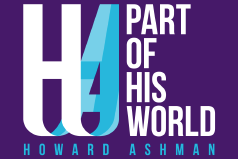Don Hahn discusses his documentary, HOWARD (PART TWO)
Howard with Little Mermaid people and creatures
(Editor's Note: Thanks for the great questions to all who responded. Final part will be published next week.)
Did Howard give you a new appreciation of live theater by bringing his theatrical training to the studio?
The connection between Disney animation and theater is deep, largely because of Howard Ashman and Peter Schneider who ran Disney Animation for many years during the 80’s and 90’s. Peter was a theater guy from Chicago and NYC who, among other things, had worked as Company Manager of Little Shop of Horrors. He was a big proponent of bringing Howard into the animation studio. But alongside that, Peter brought in a variety of people from the theater world in LA and put them in positions to manage and produce the films. He felt animation was essentially a group of actors, in this case actors with a pencil, who would go from movie to movie somewhat like a troupe of actors would go from play to play. This, along with Howard and Alan Menken’s experience, was perfect for Disney animation at that time.
Animation has always been closely related to music and almost any film or short that Walt Disney made, from Snow White to Jungle Book, featured a song score that was crucial to the plot of the films. That art was all but lost until Howard came along. He gave us a crash course in storytelling with songs, and the power of plot within the context of songs and musical storytelling. He and Alan then led by example by giving us incredible song scores for Little Mermaid, Beauty and Aladdin. Howard contributed to the process as well, changing the way that we cast our films with actors who could sing instead of singers who could act. And so much of our present-day process of creating animated films is because of those few years that Howard contributed so much to the art of animation.
Will you include the entirety of Howard’s lunchtime lecture in your film?
The clip is owned by Disney. There is a long clip of Howard’s lunchtime lecture in the documentary Howard and we also included segments of the lecture as bonus material on the Waking Sleeping Beauty DVD. We’ll include more on the DVD if we can.
How much behind the scenes video is there? What was documented on film during the making of the Little Mermaid and Beauty and the Beast? I want to see everything!
I don’t think you’ll be disappointed. Howard is made up almost entirely of archival film, video and stills. There is very little new photography in the film. I wanted to take this behind-the-scenes approach because it gives you, the audience, the best insight into Howard and how he worked. It made no sense to me to have a documentary full of talking heads and old guys reminiscing. I wanted Howard Ashman, arguably one of the great storytellers of the 20th Century, to tell his own story. That’s how the film is constructed. We uncovered hours of footage and tape from Howard’s life going back to his childhood. His years in New York theater are documented with wonderful photography, some of which hasn’t been seen in 30 years. The same is true about his time at Disney Animation. We had fantastic cooperation from Disney to acquire footage of Howard and Alan working with people like Angela Lansbury and Jerry Orbach. It’s nostalgic for me because I was there, but I wanted to put you there too, in the same rooms that I was in, so that you could see Howard at work and help you to understand his process.
How many times would Howard and Alan demo their songs?
I think there were many demos or sketches of songs that they made on working tapes well before we would hear them. Working tapes were literally that, a tape recording of the song as a work in progress, usually with just piano and Howard and Alan singing. These work tapes were never meant for public consumption. They were sketch recordings that they could listen to later as they continued to polish a song or a lyric.
When it came time to share a song with the studio, Howard and Alan created a more polished demo tape with as much production value as possible. Howard often sang the lead on these final demos, the performances were incredible, and they were clear with no ambiguity so that the film makers and studio executives would understand exactly what the song was about and what is was supposed to do. The demos even contained the dialogue leading up to the song, and any book scenes within the song, all of which were perfectly fit to music. So there were likely several [1] work tapes on each song, but we, the film makers, generally got just one beautiful demo tape of the final fully baked song. Occasionally, if we needed a song cut because of length or if we needed changes, we would ask for another demo, but this was very rare. Howard and Alan came incredibly close to the mark with the initial demos they sent in.

